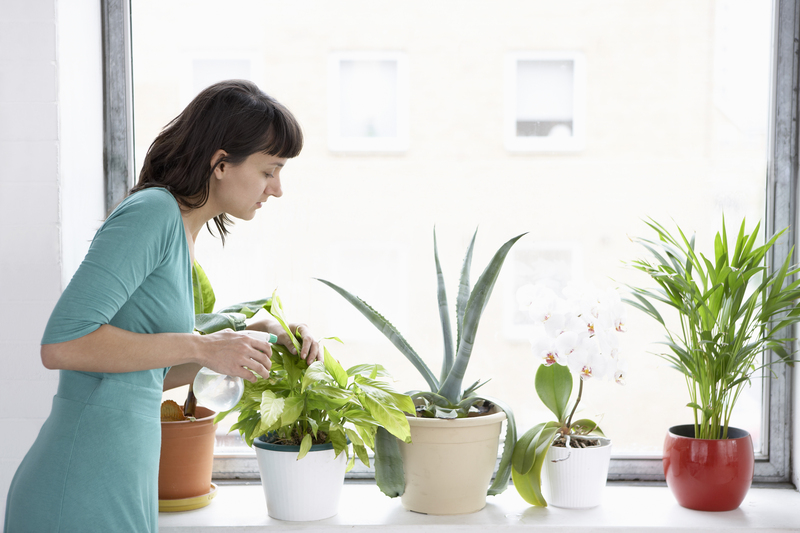Vertical Gardening: Bringing Greenery to New Heights
Posted on 14/08/2025
Vertical Gardening: Bringing Greenery to New Heights
Vertical gardening is revolutionizing the way we think about growing plants, especially in urban environments where space is at a premium. This innovative gardening technique lets you cultivate flowers, herbs, vegetables, and more by going UP instead of OUT, maximizing every inch of available space. Vertical gardens--also known as living walls or green walls--are not only eye-catching but also practical, sustainable, and beneficial for both people and the planet.
What Is Vertical Gardening?
Vertical gardening refers to cultivating plants on a vertically suspended panel, wall, or framework. Instead of the traditional horizontal planting in garden beds, plants are grown upwards, attached to a vertical support structure. This gardening method can be used both indoors and outdoors, transforming otherwise blank walls, fences, balconies, and small patios into vibrant, living spaces.
Whether you have a large backyard or just a tiny apartment balcony, vertical green spaces can help you bring lushness and color to any space!

Benefits of Vertical Gardening
Vertical gardens offer a myriad of benefits, not only for the individual gardener but also for communities and cityscapes as a whole. Here are just a few compelling reasons to embrace this green trend:
- Space Efficiency: Perfect for small urban apartments or compact backyards, vertical gardening makes use of unused vertical areas to cultivate more plants in less space.
- Improved Air Quality: Plants are natural air purifiers. By increasing plant density through living walls, you improve air quality by filtering pollutants and carbon dioxide.
- Aesthetic Appeal: Vertical gardens serve as stunning visual features, bringing life, color, and texture to dull walls and urban landscapes.
- Thermal Insulation: Living walls help regulate indoor temperatures, leading to energy savings by acting as natural insulators for buildings.
- No Bending Required: Tending to vertical gardens is easier on your back and knees, since many of the plants are grown at eye level or higher.
- Increased Biodiversity: Vertical spaces encourage the growth of a variety of plants, which can attract pollinators and beneficial insects.
- Noise Reduction: Lush green walls help to absorb sound, making them ideal for improving acoustics in noisy city environments.
- Year-Round Gardening: Many vertical systems can be brought indoors or used with controlled environments, allowing for fresh produce all year long.
Popular Types of Vertical Gardening Systems
There isn't a one-size-fits-all approach! Here are some of the most popular vertical gardening systems:
1. Living Walls or Green Walls
These are the most dramatic type of vertical gardens and are often seen in commercial or public buildings, but they're growing in popularity for homes too. A green wall consists of a support system (often modular panels), potting media, irrigation, and a wide variety of plants that cover the surface area. Living walls can be freestanding or attached to existing walls for a breathtaking indoor or outdoor display.
2. Vertical Planter Boxes and Pocket Systems
Here, planters or pockets made from recycled materials, felt, or other durable fabrics are attached to a wall or frame. Each pocket can house a small plant, herb, or flower, making for an organized and accessible edible or ornamental wall garden.
3. Trellis and Climbing Structures
Classic vertical gardening structures like trellises, arbors, and obelisks support climbing plants such as peas, beans, cucumbers, and flowering vines. These low-cost options are perfect for vegetable gardeners and add vertical interest to your plot.
4. Pallet Gardens
Repurposed shipping pallets can be mounted against a wall or leaned upright, filled with soil and plants in the gaps between pallet planks. Pallet gardens are an affordable DIY method to start your own vertical vegetable or herb garden.
5. Hanging Systems
Individual pots or containers can be suspended from walls, railings, or even the ceiling to create a dynamic hanging garden. Tiered hanging baskets and creative arrangements allow for artistic green displays in small spaces.
Designing Your Own Vertical Garden
Designing a vertical gardening system can be as simple or as elaborate as you wish. Here's a step-by-step guide to get you started:
1. Assess Your Space
- Indoors or Outdoors: Determine where you want your greenery--inside, outside, or both!
- Sunlight: Measure how much natural light hits the area. This will affect which plants you can choose.
- Wall Material: Make sure the mounting surface can support your intended garden's weight when watered.
2. Choose a Vertical Gardening System
- For a bold look, opt for a living wall with modular panels.
- On a budget? Try DIY pallet gardens or use recycled containers.
- Prefer something temporary? Hanging pots or rail planters allow for seasonal change-ups.
3. Pick the Right Plants
Not all plants are suitable for vertical spaces. Here are some ideal options:
- Herbs: Basil, mint, parsley, thyme, and chives thrive in pocket gardens.
- Leafy Greens: Lettuce, spinach, arugula, and Swiss chard grow well vertically.
- Flowering Plants: Ferns, petunias, nasturtiums, and trailing begonias add color and movement.
- Climbers & Vines: Ivy, peas, cucumbers, and pole beans are natural vertical candidates.
- Succulents: For low-maintenance needs, select succulents that require less frequent watering.
4. Soil, Fertilizer, and Watering Considerations
- Soil: Use high-quality, lightweight potting mixes that drain well and retain moisture.
- Fertilizer: Regular feeding will be essential since vertical gardens dry out faster and have limited soil volume.
- Watering: Depending on your design, consider self-watering systems or drip irrigation for consistent moisture.
Step-by-Step: How to Build a Simple Vertical Garden
If you're new to vertical gardening, begin small! Here's how:
- Choose Your Location: Find a wall or fence with good sunlight or a well-lit indoor area.
- Select Your Structure: Purchase or make a planter panel, pocket wall, or simply recycle a wooden pallet.
- Prepare Your Plants: Choose plants suited to light and climate. Arrange for a blend of trailing, upright, and bushy species for visual interest.
- Mount the Structure: Securely fix the structure to the wall using proper anchors or brackets.
- Fill with Soil and Plant: Add potting soil and carefully plant your selections, ensuring appropriate spacing.
- Water and Maintain: Water immediately after planting. Regularly fertilize, prune, and check for pests.
Tip: Label your plants and keep a planting log to track what thrives best in your unique vertical garden environment!
Creative Ideas for Vertical Green Spaces
Let your imagination run wild! Here are some creative and unusual ways to bring vertical greenery into your living or working space:
- Outdoor Privacy Screens: Train tall vines or tall grasses on trellises to create a lush and green privacy wall.
- Kitchen Herb Wall: Dedicate a section of your kitchen or balcony to fresh herbs for convenient, organic cooking ingredients.
- Living Art: Arrange succulents or colorful annuals in designs or patterns to form a living painting on your walls.
- Pocket Shoe Organizers: Repurpose hanging over-the-door shoe organizers as pocket planters for compact herbs and flowering plants.
- Bottle Gardens: Upcycle plastic bottles or jars, mounting them to a wall to grow a mix of trailing and upright plants.
- Indoor Moss Walls: Create a calming, low-maintenance moss wall for a soft, natural accent in living rooms or offices.
Best Plants for Vertical Gardens
Not all plant species are equally suited for vertical gardening. To achieve thriving, lush results, consider these vertical garden plant options:
Edible Plants
- Lettuce, kale, spinach (for cut-and-come-again harvests)
- Strawberries (trailing variety work great in wall pockets)
- Tomatoes (compact or cherry varieties)
- Climbing peas and pole beans
- Herbs: oregano, basil, thyme, dill, cilantro
Ornamental and Flowering Plants
- Ferns, especially Boston fern and maidenhair
- Pothos and philodendron (hardy, trailing foliage)
- Begonias and impatiens for pops of color
- Orchids, for an exotic touch in humid indoor environments
- Ivy, jasmine, and clematis vines
- Succulents for geometric or arid-climate designs
Tip: Mix and match textures and colors for a multidimensional, visually stunning vertical display!
Maintenance Tips for Thriving Vertical Gardens
To keep your vertical garden lush and healthy, follow these ongoing care guidelines:
- Consistent Watering: Vertical plantings typically dry out faster than ground gardens. Consider using drip irrigation or self-watering planters for even moisture. Monitor closely during summer or in heated interiors.
- Fertilization: With less soil, nutrients are quickly depleted. Use slow-release fertilizer or feed diluted liquid fertilizer every few weeks as needed.
- Pruning: Trim back growth regularly to maintain shape, encourage bushier plants, and remove any dead or yellowing leaves.
- Pest and Disease Checks: Keep a lookout for pests or fungal issues, especially in tightly packed arrangements. Natural and organic pest solutions are best for edible gardens.
- Rotation: Don't be afraid to swap out plants seasonally or experiment with new varieties for continuous interest.
The Environmental Impact of Vertical Green Spaces
Adopting vertical gardens is more than just a space-saving solution--it's a step toward sustainability and environmental wellness:
- Reduced Urban Heat: Living walls help cool city buildings, mitigating the "urban heat island" effect.
- Rainwater Management: Root systems and soil filters help catch and utilize rainwater, reducing runoff.
- Wildlife Habitat: Vertical plantings attract pollinators, beneficial insects, and urban wildlife, promoting biodiversity.
- Air Filtration: Denser plantings absorb more carbon dioxide and filter airborne particulates, improving city air.
Vertical Gardening Trends and Innovations
The vertical gardening landscape is evolving rapidly, with new techniques and technologies emerging each year. Here are some of the latest trends:
- Automated Vertical Farms: High-tech indoor vertical farming uses hydroponics or aeroponics, LED lighting, and automated climate controls to grow food year-round in city centers.
- Edible Living Walls: Restaurants, offices, and schools are adopting edible green walls, producing salad greens and herbs right on site.
- Modular and DIY Systems: More user-friendly kits are making it easy for anyone to start a vertical garden, regardless of experience or budget.
- Architectural Integration: Creative architects are designing buildings with built-in green facades and vertical greenery as a key feature.

Getting Started: Tips for New Vertical Gardeners
Ready to embark on your own vertical gardening adventure? Here are some final tips get you started on the right foot:
- Start Small: Even a single hanging planter or wall pocket can make a difference. Add more as your confidence grows.
- Experiment: Try different plants and systems to see what works best for your space and climate.
- Set a Schedule: Regular checks on water, nutrients, and plant health ensure ongoing success--set reminders if needed!
- Connect with Other Gardeners: Join local gardening clubs, online forums, or social media groups for advice, inspiration, and troubleshooting tips.
Conclusion: Take Your Garden to New Heights
Vertical gardening is the smart, stylish, and sustainable way to introduce more plant life into today's compact living spaces. By growing upwards, you can transform drab walls, balconies, or small patios into thriving oases of greenery--while also improving air quality, supporting biodiversity, and enjoying the mental and physical rewards of tending to living plants. With a little creativity and the right know-how, anyone can succeed in bringing greenery to new heights.
Start your own vertical garden today--and help bring a little more green to your corner of the world!

